The Impact of Age and Education on Income Levels: A UK Study
VerifiedAdded on 2021/05/30
|19
|3620
|346
Report
AI Summary
This report investigates the relationship between age, education, and income levels in the UK, utilizing quantitative research methods and secondary data from the World Value Survey. The study aims to establish the impact of age and educational attainment on individual income, formulating hypotheses about positive correlations between education and income and negative correlations between age and income. The methodology involves a deductive and exploratory approach, employing descriptive statistics, correlation analysis, and regression analysis to examine data from 1041 UK residents. The analysis includes assessing data distribution, multicollinearity, and homoscedasticity, with findings presented in tables and figures. The report discusses the descriptive statistics of the sample, including education levels, age distribution, and income scales. Furthermore, the study analyzes the coefficients, collinearity statistics, and normal Q-Q plots to test the assumptions of the regression analysis. Overall, the research seeks to provide empirical evidence supporting the hypothesized relationships, contributing to a deeper understanding of labor market dynamics and income inequality in the UK.
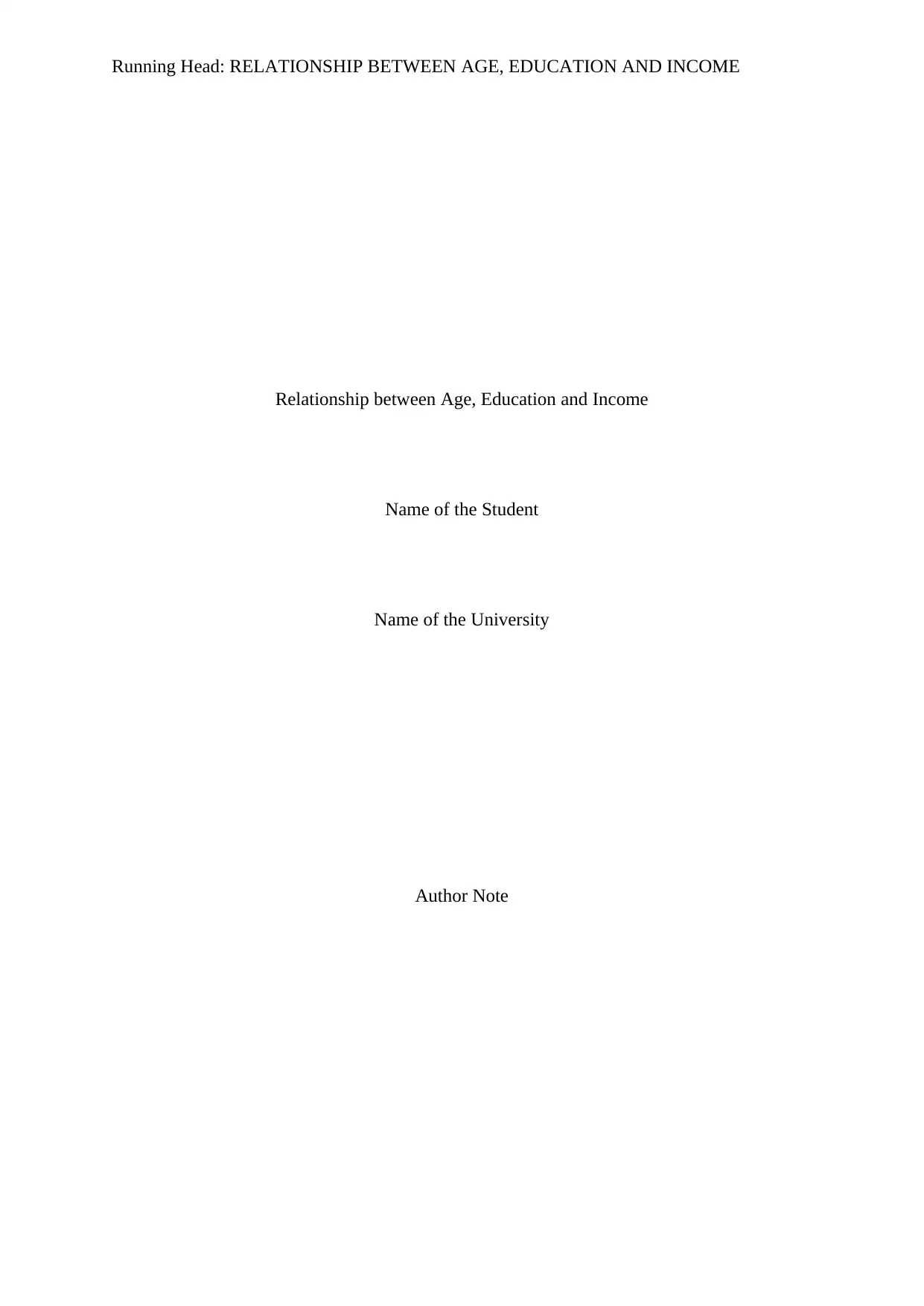
Running Head: RELATIONSHIP BETWEEN AGE, EDUCATION AND INCOME
Relationship between Age, Education and Income
Name of the Student
Name of the University
Author Note
Relationship between Age, Education and Income
Name of the Student
Name of the University
Author Note
Paraphrase This Document
Need a fresh take? Get an instant paraphrase of this document with our AI Paraphraser

1RELATIONSHIP BETWEEN AGE, EDUCATION AND INCOME
Table of Contents
1.0 Introduction..........................................................................................................................2
2.0 Conceptual Framework........................................................................................................3
3.0 Methodology........................................................................................................................4
4.0 Data Analysis and Results....................................................................................................6
4.1 Description.......................................................................................................................6
4.2 Assumptions...................................................................................................................11
4.3 Correlation......................................................................................................................11
4.4 Regression......................................................................................................................12
5.0 Discussion and Conclusion................................................................................................13
References................................................................................................................................15
Appendix..................................................................................................................................17
Table of Contents
1.0 Introduction..........................................................................................................................2
2.0 Conceptual Framework........................................................................................................3
3.0 Methodology........................................................................................................................4
4.0 Data Analysis and Results....................................................................................................6
4.1 Description.......................................................................................................................6
4.2 Assumptions...................................................................................................................11
4.3 Correlation......................................................................................................................11
4.4 Regression......................................................................................................................12
5.0 Discussion and Conclusion................................................................................................13
References................................................................................................................................15
Appendix..................................................................................................................................17
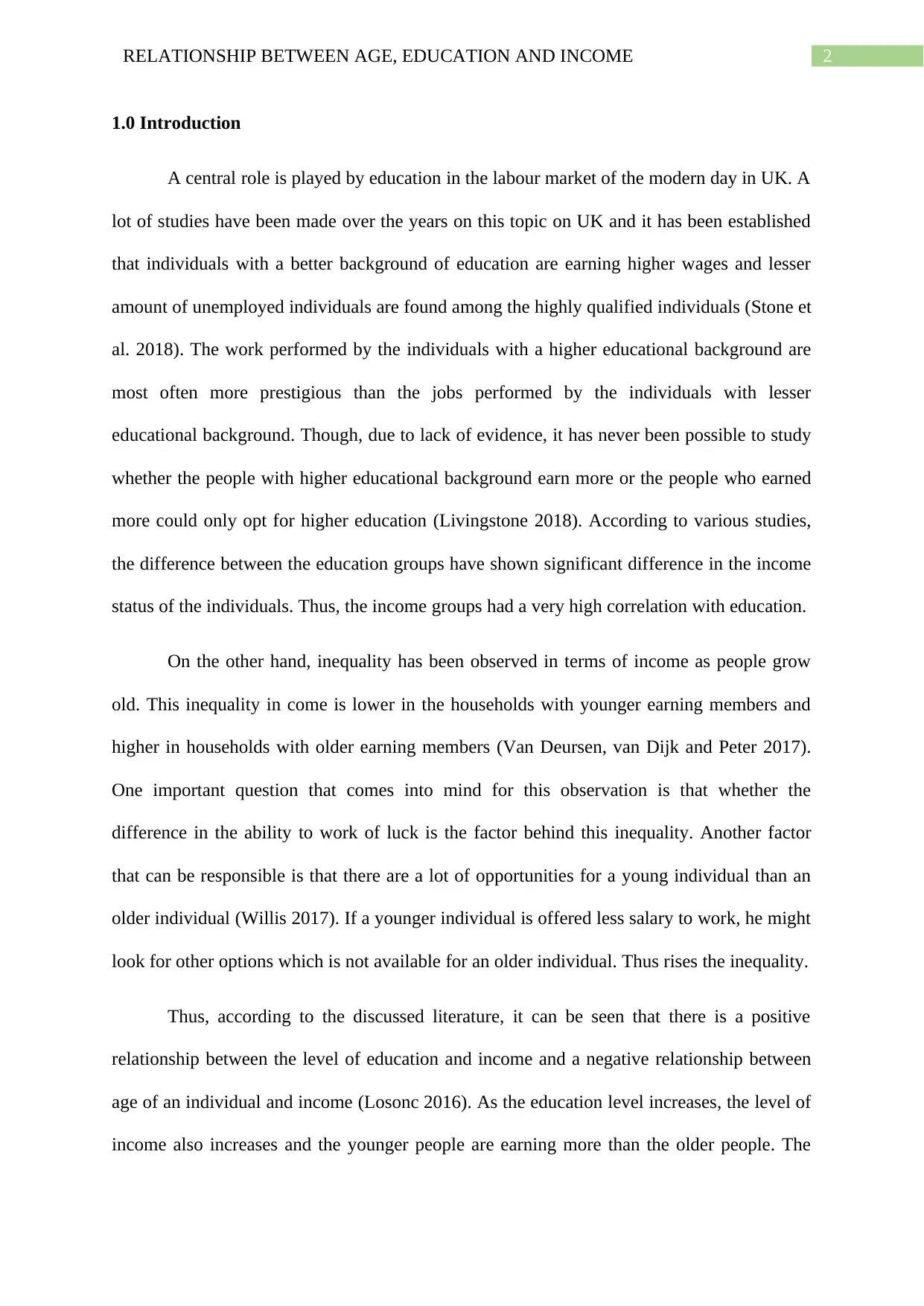
2RELATIONSHIP BETWEEN AGE, EDUCATION AND INCOME
1.0 Introduction
A central role is played by education in the labour market of the modern day in UK. A
lot of studies have been made over the years on this topic on UK and it has been established
that individuals with a better background of education are earning higher wages and lesser
amount of unemployed individuals are found among the highly qualified individuals (Stone et
al. 2018). The work performed by the individuals with a higher educational background are
most often more prestigious than the jobs performed by the individuals with lesser
educational background. Though, due to lack of evidence, it has never been possible to study
whether the people with higher educational background earn more or the people who earned
more could only opt for higher education (Livingstone 2018). According to various studies,
the difference between the education groups have shown significant difference in the income
status of the individuals. Thus, the income groups had a very high correlation with education.
On the other hand, inequality has been observed in terms of income as people grow
old. This inequality in come is lower in the households with younger earning members and
higher in households with older earning members (Van Deursen, van Dijk and Peter 2017).
One important question that comes into mind for this observation is that whether the
difference in the ability to work of luck is the factor behind this inequality. Another factor
that can be responsible is that there are a lot of opportunities for a young individual than an
older individual (Willis 2017). If a younger individual is offered less salary to work, he might
look for other options which is not available for an older individual. Thus rises the inequality.
Thus, according to the discussed literature, it can be seen that there is a positive
relationship between the level of education and income and a negative relationship between
age of an individual and income (Losonc 2016). As the education level increases, the level of
income also increases and the younger people are earning more than the older people. The
1.0 Introduction
A central role is played by education in the labour market of the modern day in UK. A
lot of studies have been made over the years on this topic on UK and it has been established
that individuals with a better background of education are earning higher wages and lesser
amount of unemployed individuals are found among the highly qualified individuals (Stone et
al. 2018). The work performed by the individuals with a higher educational background are
most often more prestigious than the jobs performed by the individuals with lesser
educational background. Though, due to lack of evidence, it has never been possible to study
whether the people with higher educational background earn more or the people who earned
more could only opt for higher education (Livingstone 2018). According to various studies,
the difference between the education groups have shown significant difference in the income
status of the individuals. Thus, the income groups had a very high correlation with education.
On the other hand, inequality has been observed in terms of income as people grow
old. This inequality in come is lower in the households with younger earning members and
higher in households with older earning members (Van Deursen, van Dijk and Peter 2017).
One important question that comes into mind for this observation is that whether the
difference in the ability to work of luck is the factor behind this inequality. Another factor
that can be responsible is that there are a lot of opportunities for a young individual than an
older individual (Willis 2017). If a younger individual is offered less salary to work, he might
look for other options which is not available for an older individual. Thus rises the inequality.
Thus, according to the discussed literature, it can be seen that there is a positive
relationship between the level of education and income and a negative relationship between
age of an individual and income (Losonc 2016). As the education level increases, the level of
income also increases and the younger people are earning more than the older people. The
⊘ This is a preview!⊘
Do you want full access?
Subscribe today to unlock all pages.

Trusted by 1+ million students worldwide
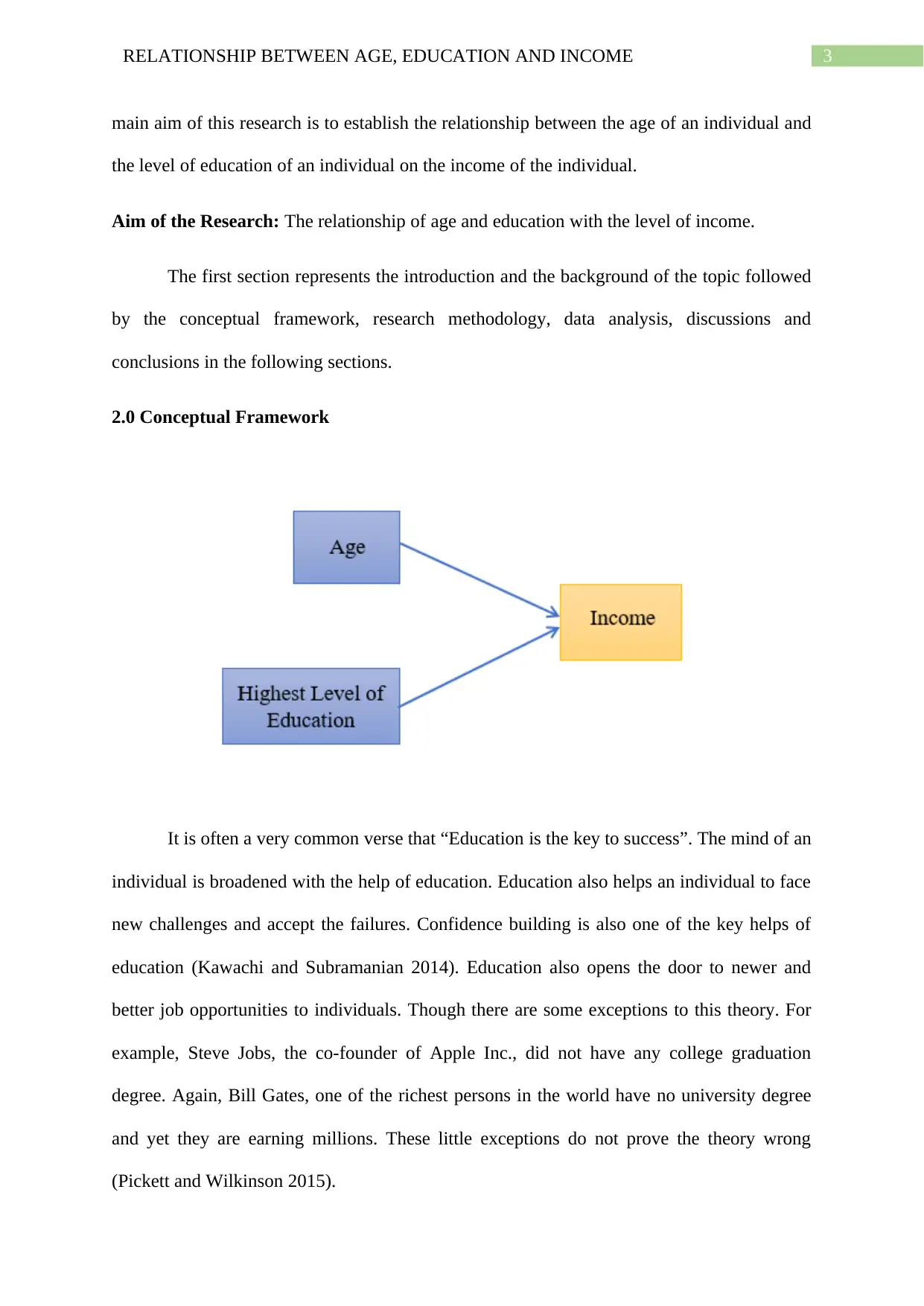
3RELATIONSHIP BETWEEN AGE, EDUCATION AND INCOME
main aim of this research is to establish the relationship between the age of an individual and
the level of education of an individual on the income of the individual.
Aim of the Research: The relationship of age and education with the level of income.
The first section represents the introduction and the background of the topic followed
by the conceptual framework, research methodology, data analysis, discussions and
conclusions in the following sections.
2.0 Conceptual Framework
It is often a very common verse that “Education is the key to success”. The mind of an
individual is broadened with the help of education. Education also helps an individual to face
new challenges and accept the failures. Confidence building is also one of the key helps of
education (Kawachi and Subramanian 2014). Education also opens the door to newer and
better job opportunities to individuals. Though there are some exceptions to this theory. For
example, Steve Jobs, the co-founder of Apple Inc., did not have any college graduation
degree. Again, Bill Gates, one of the richest persons in the world have no university degree
and yet they are earning millions. These little exceptions do not prove the theory wrong
(Pickett and Wilkinson 2015).
main aim of this research is to establish the relationship between the age of an individual and
the level of education of an individual on the income of the individual.
Aim of the Research: The relationship of age and education with the level of income.
The first section represents the introduction and the background of the topic followed
by the conceptual framework, research methodology, data analysis, discussions and
conclusions in the following sections.
2.0 Conceptual Framework
It is often a very common verse that “Education is the key to success”. The mind of an
individual is broadened with the help of education. Education also helps an individual to face
new challenges and accept the failures. Confidence building is also one of the key helps of
education (Kawachi and Subramanian 2014). Education also opens the door to newer and
better job opportunities to individuals. Though there are some exceptions to this theory. For
example, Steve Jobs, the co-founder of Apple Inc., did not have any college graduation
degree. Again, Bill Gates, one of the richest persons in the world have no university degree
and yet they are earning millions. These little exceptions do not prove the theory wrong
(Pickett and Wilkinson 2015).
Paraphrase This Document
Need a fresh take? Get an instant paraphrase of this document with our AI Paraphraser
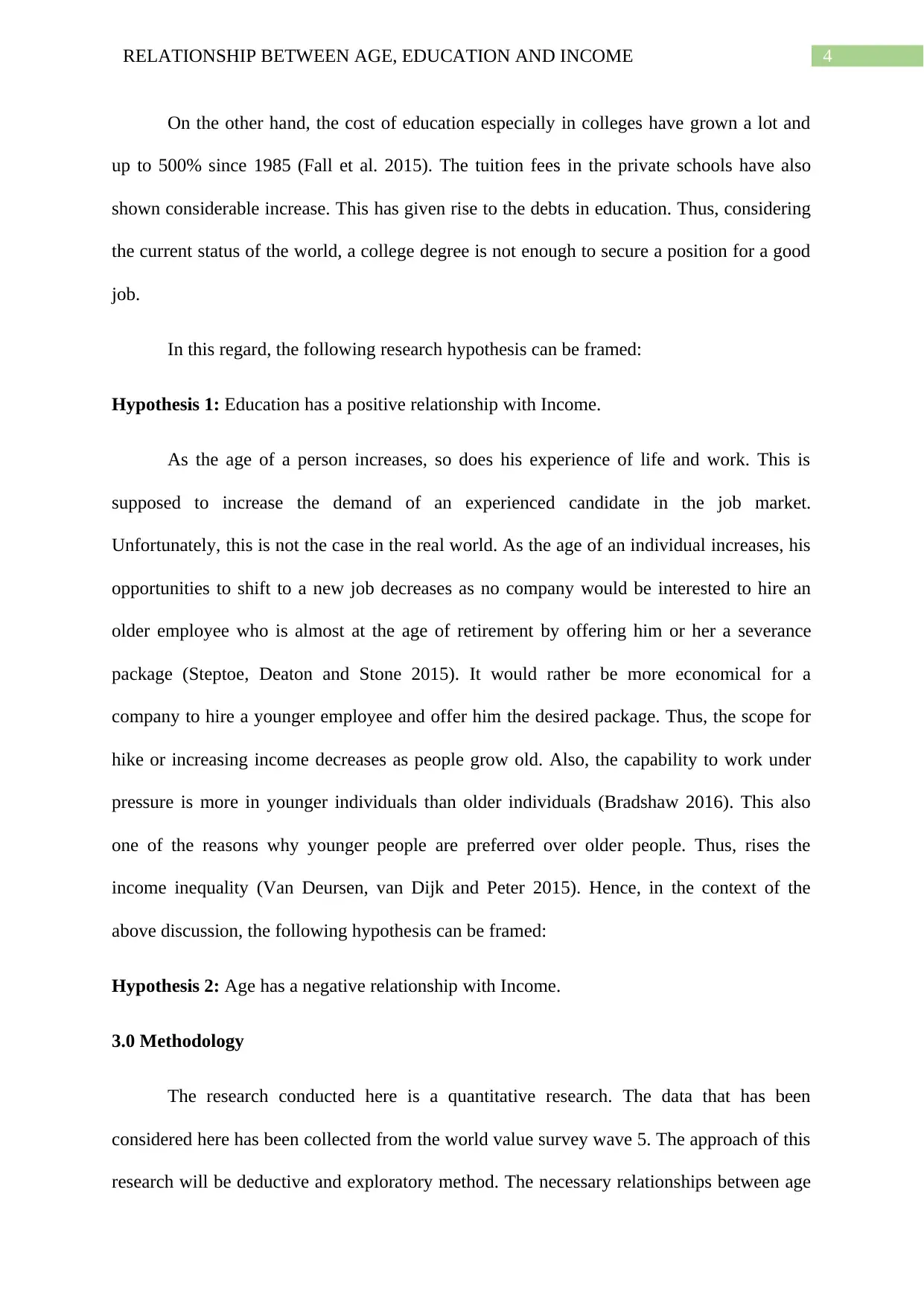
4RELATIONSHIP BETWEEN AGE, EDUCATION AND INCOME
On the other hand, the cost of education especially in colleges have grown a lot and
up to 500% since 1985 (Fall et al. 2015). The tuition fees in the private schools have also
shown considerable increase. This has given rise to the debts in education. Thus, considering
the current status of the world, a college degree is not enough to secure a position for a good
job.
In this regard, the following research hypothesis can be framed:
Hypothesis 1: Education has a positive relationship with Income.
As the age of a person increases, so does his experience of life and work. This is
supposed to increase the demand of an experienced candidate in the job market.
Unfortunately, this is not the case in the real world. As the age of an individual increases, his
opportunities to shift to a new job decreases as no company would be interested to hire an
older employee who is almost at the age of retirement by offering him or her a severance
package (Steptoe, Deaton and Stone 2015). It would rather be more economical for a
company to hire a younger employee and offer him the desired package. Thus, the scope for
hike or increasing income decreases as people grow old. Also, the capability to work under
pressure is more in younger individuals than older individuals (Bradshaw 2016). This also
one of the reasons why younger people are preferred over older people. Thus, rises the
income inequality (Van Deursen, van Dijk and Peter 2015). Hence, in the context of the
above discussion, the following hypothesis can be framed:
Hypothesis 2: Age has a negative relationship with Income.
3.0 Methodology
The research conducted here is a quantitative research. The data that has been
considered here has been collected from the world value survey wave 5. The approach of this
research will be deductive and exploratory method. The necessary relationships between age
On the other hand, the cost of education especially in colleges have grown a lot and
up to 500% since 1985 (Fall et al. 2015). The tuition fees in the private schools have also
shown considerable increase. This has given rise to the debts in education. Thus, considering
the current status of the world, a college degree is not enough to secure a position for a good
job.
In this regard, the following research hypothesis can be framed:
Hypothesis 1: Education has a positive relationship with Income.
As the age of a person increases, so does his experience of life and work. This is
supposed to increase the demand of an experienced candidate in the job market.
Unfortunately, this is not the case in the real world. As the age of an individual increases, his
opportunities to shift to a new job decreases as no company would be interested to hire an
older employee who is almost at the age of retirement by offering him or her a severance
package (Steptoe, Deaton and Stone 2015). It would rather be more economical for a
company to hire a younger employee and offer him the desired package. Thus, the scope for
hike or increasing income decreases as people grow old. Also, the capability to work under
pressure is more in younger individuals than older individuals (Bradshaw 2016). This also
one of the reasons why younger people are preferred over older people. Thus, rises the
income inequality (Van Deursen, van Dijk and Peter 2015). Hence, in the context of the
above discussion, the following hypothesis can be framed:
Hypothesis 2: Age has a negative relationship with Income.
3.0 Methodology
The research conducted here is a quantitative research. The data that has been
considered here has been collected from the world value survey wave 5. The approach of this
research will be deductive and exploratory method. The necessary relationships between age

5RELATIONSHIP BETWEEN AGE, EDUCATION AND INCOME
and education with income will be established with the help of these deductive and
exploratory approaches. These approaches are further discussed in the results section.
The data on age, education level and income of the individuals have been collected
from a secondary source. Thus, there was no need to develop a questionnaire and distribute it
to collect data on these attributes. The data has been collected on 1041 individuals of the
United Kingdom. The downloaded dataset contained information of a lot of individuals
residing in the United Kingdom. Among all the individuals, 1041 individuals have been
selected randomly for the purpose of the study.
From the data, it can be clearly understood that each of the individuals were asked
about their age and the highest degree of education attained by them. For the variable income,
the respondents were not asked directly the amount of income. Instead, they were asked to
mark the appropriate range within which their income lies.
The main aim of this research is to establish a relationship between age, education
level and income of the respondents. Moreover, the effect of age and level of education on
the income of the respondents has to be established. Thus, age of the respondents and the
highest level of education attained by the respondents have been considered as the predictor
variables or independent variables and the income of the respondents have been considered as
the response variable or the dependent variable.
This research is performed using secondary data. There are some strengths and
weaknesses of using secondary data in a research. There are a lot of secondary data available
freely. Thus, data can be selected according to the purpose of the research accordingly. The
past data can be researched with the help of the official statistics. There are certain limitations
as well to the data. The data collected might not be authentic and some parts of the data might
be missing. No information about the collector of the data can also be obtained and thus
and education with income will be established with the help of these deductive and
exploratory approaches. These approaches are further discussed in the results section.
The data on age, education level and income of the individuals have been collected
from a secondary source. Thus, there was no need to develop a questionnaire and distribute it
to collect data on these attributes. The data has been collected on 1041 individuals of the
United Kingdom. The downloaded dataset contained information of a lot of individuals
residing in the United Kingdom. Among all the individuals, 1041 individuals have been
selected randomly for the purpose of the study.
From the data, it can be clearly understood that each of the individuals were asked
about their age and the highest degree of education attained by them. For the variable income,
the respondents were not asked directly the amount of income. Instead, they were asked to
mark the appropriate range within which their income lies.
The main aim of this research is to establish a relationship between age, education
level and income of the respondents. Moreover, the effect of age and level of education on
the income of the respondents has to be established. Thus, age of the respondents and the
highest level of education attained by the respondents have been considered as the predictor
variables or independent variables and the income of the respondents have been considered as
the response variable or the dependent variable.
This research is performed using secondary data. There are some strengths and
weaknesses of using secondary data in a research. There are a lot of secondary data available
freely. Thus, data can be selected according to the purpose of the research accordingly. The
past data can be researched with the help of the official statistics. There are certain limitations
as well to the data. The data collected might not be authentic and some parts of the data might
be missing. No information about the collector of the data can also be obtained and thus
⊘ This is a preview!⊘
Do you want full access?
Subscribe today to unlock all pages.

Trusted by 1+ million students worldwide
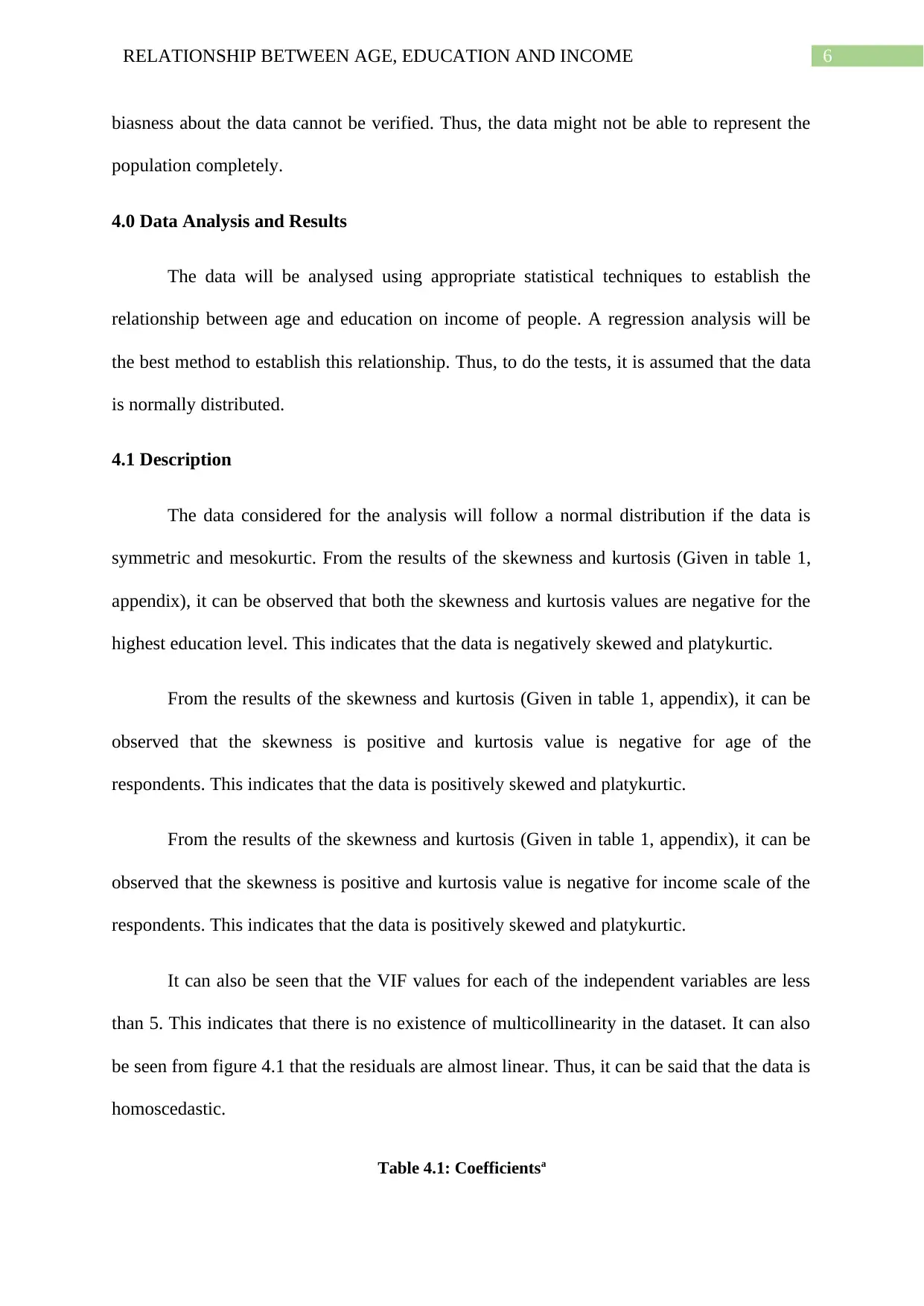
6RELATIONSHIP BETWEEN AGE, EDUCATION AND INCOME
biasness about the data cannot be verified. Thus, the data might not be able to represent the
population completely.
4.0 Data Analysis and Results
The data will be analysed using appropriate statistical techniques to establish the
relationship between age and education on income of people. A regression analysis will be
the best method to establish this relationship. Thus, to do the tests, it is assumed that the data
is normally distributed.
4.1 Description
The data considered for the analysis will follow a normal distribution if the data is
symmetric and mesokurtic. From the results of the skewness and kurtosis (Given in table 1,
appendix), it can be observed that both the skewness and kurtosis values are negative for the
highest education level. This indicates that the data is negatively skewed and platykurtic.
From the results of the skewness and kurtosis (Given in table 1, appendix), it can be
observed that the skewness is positive and kurtosis value is negative for age of the
respondents. This indicates that the data is positively skewed and platykurtic.
From the results of the skewness and kurtosis (Given in table 1, appendix), it can be
observed that the skewness is positive and kurtosis value is negative for income scale of the
respondents. This indicates that the data is positively skewed and platykurtic.
It can also be seen that the VIF values for each of the independent variables are less
than 5. This indicates that there is no existence of multicollinearity in the dataset. It can also
be seen from figure 4.1 that the residuals are almost linear. Thus, it can be said that the data is
homoscedastic.
Table 4.1: Coefficientsa
biasness about the data cannot be verified. Thus, the data might not be able to represent the
population completely.
4.0 Data Analysis and Results
The data will be analysed using appropriate statistical techniques to establish the
relationship between age and education on income of people. A regression analysis will be
the best method to establish this relationship. Thus, to do the tests, it is assumed that the data
is normally distributed.
4.1 Description
The data considered for the analysis will follow a normal distribution if the data is
symmetric and mesokurtic. From the results of the skewness and kurtosis (Given in table 1,
appendix), it can be observed that both the skewness and kurtosis values are negative for the
highest education level. This indicates that the data is negatively skewed and platykurtic.
From the results of the skewness and kurtosis (Given in table 1, appendix), it can be
observed that the skewness is positive and kurtosis value is negative for age of the
respondents. This indicates that the data is positively skewed and platykurtic.
From the results of the skewness and kurtosis (Given in table 1, appendix), it can be
observed that the skewness is positive and kurtosis value is negative for income scale of the
respondents. This indicates that the data is positively skewed and platykurtic.
It can also be seen that the VIF values for each of the independent variables are less
than 5. This indicates that there is no existence of multicollinearity in the dataset. It can also
be seen from figure 4.1 that the residuals are almost linear. Thus, it can be said that the data is
homoscedastic.
Table 4.1: Coefficientsa
Paraphrase This Document
Need a fresh take? Get an instant paraphrase of this document with our AI Paraphraser
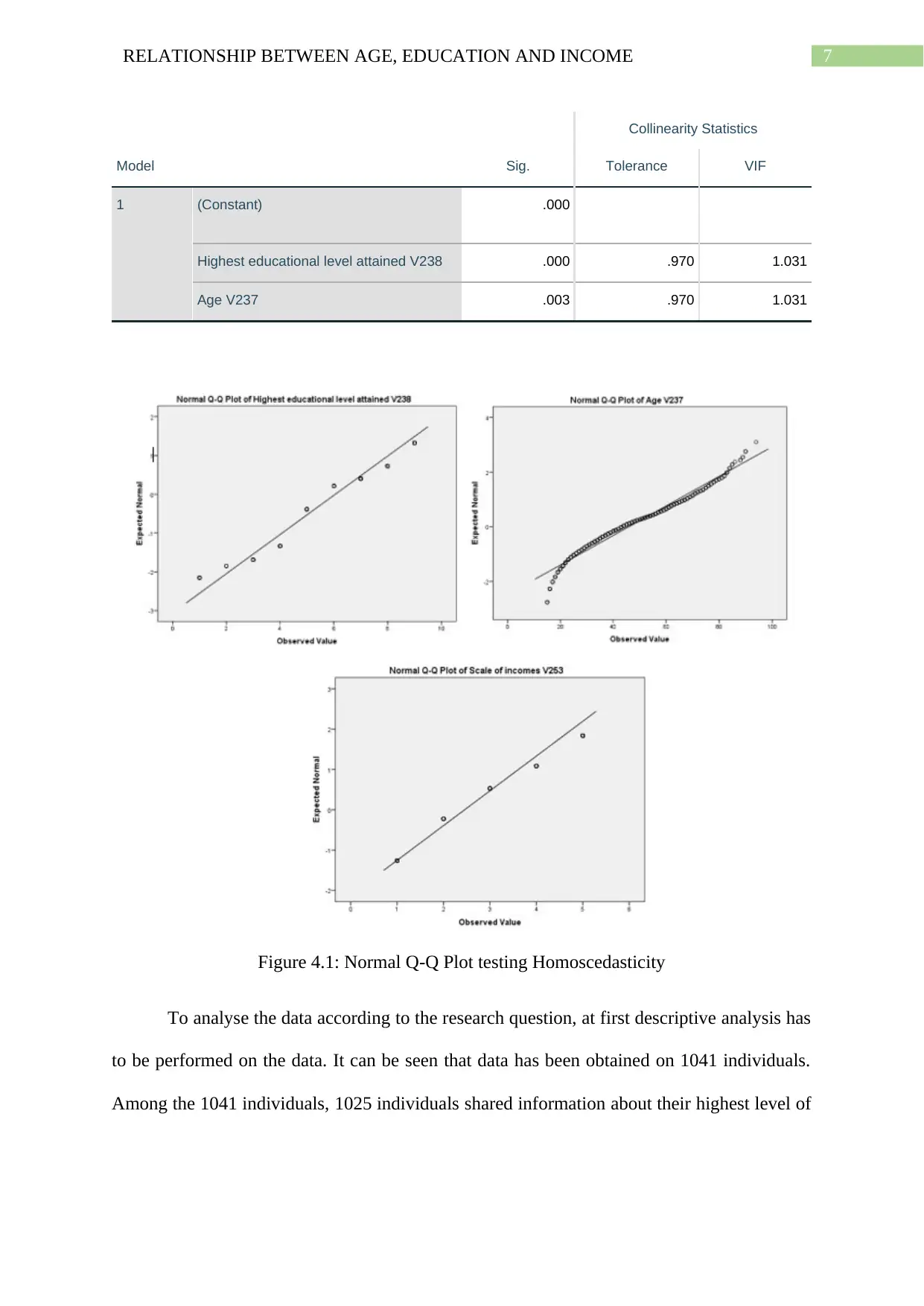
7RELATIONSHIP BETWEEN AGE, EDUCATION AND INCOME
Model Sig.
Collinearity Statistics
Tolerance VIF
1 (Constant) .000
Highest educational level attained V238 .000 .970 1.031
Age V237 .003 .970 1.031
Figure 4.1: Normal Q-Q Plot testing Homoscedasticity
To analyse the data according to the research question, at first descriptive analysis has
to be performed on the data. It can be seen that data has been obtained on 1041 individuals.
Among the 1041 individuals, 1025 individuals shared information about their highest level of
Model Sig.
Collinearity Statistics
Tolerance VIF
1 (Constant) .000
Highest educational level attained V238 .000 .970 1.031
Age V237 .003 .970 1.031
Figure 4.1: Normal Q-Q Plot testing Homoscedasticity
To analyse the data according to the research question, at first descriptive analysis has
to be performed on the data. It can be seen that data has been obtained on 1041 individuals.
Among the 1041 individuals, 1025 individuals shared information about their highest level of
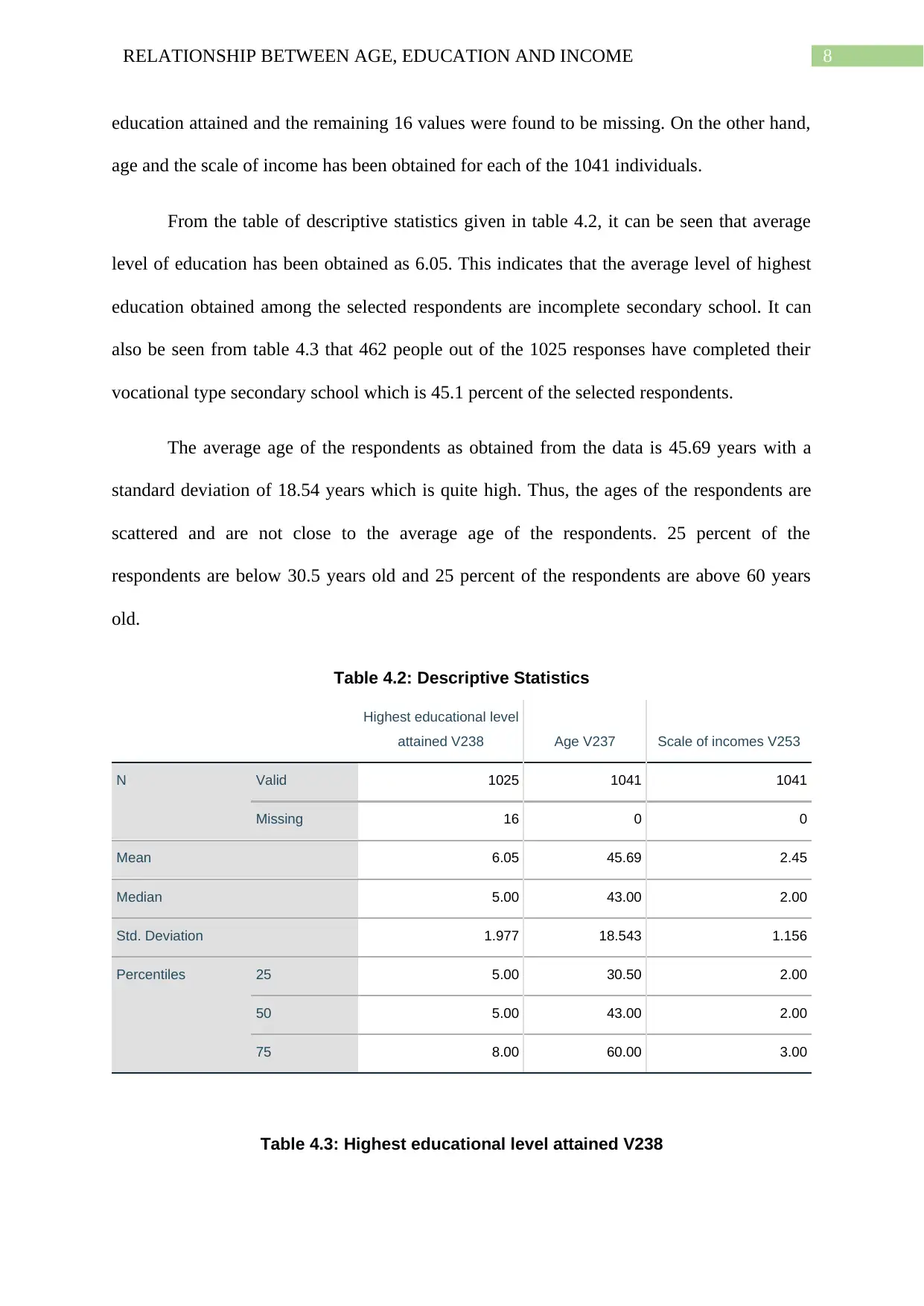
8RELATIONSHIP BETWEEN AGE, EDUCATION AND INCOME
education attained and the remaining 16 values were found to be missing. On the other hand,
age and the scale of income has been obtained for each of the 1041 individuals.
From the table of descriptive statistics given in table 4.2, it can be seen that average
level of education has been obtained as 6.05. This indicates that the average level of highest
education obtained among the selected respondents are incomplete secondary school. It can
also be seen from table 4.3 that 462 people out of the 1025 responses have completed their
vocational type secondary school which is 45.1 percent of the selected respondents.
The average age of the respondents as obtained from the data is 45.69 years with a
standard deviation of 18.54 years which is quite high. Thus, the ages of the respondents are
scattered and are not close to the average age of the respondents. 25 percent of the
respondents are below 30.5 years old and 25 percent of the respondents are above 60 years
old.
Table 4.2: Descriptive Statistics
Highest educational level
attained V238 Age V237 Scale of incomes V253
N Valid 1025 1041 1041
Missing 16 0 0
Mean 6.05 45.69 2.45
Median 5.00 43.00 2.00
Std. Deviation 1.977 18.543 1.156
Percentiles 25 5.00 30.50 2.00
50 5.00 43.00 2.00
75 8.00 60.00 3.00
Table 4.3: Highest educational level attained V238
education attained and the remaining 16 values were found to be missing. On the other hand,
age and the scale of income has been obtained for each of the 1041 individuals.
From the table of descriptive statistics given in table 4.2, it can be seen that average
level of education has been obtained as 6.05. This indicates that the average level of highest
education obtained among the selected respondents are incomplete secondary school. It can
also be seen from table 4.3 that 462 people out of the 1025 responses have completed their
vocational type secondary school which is 45.1 percent of the selected respondents.
The average age of the respondents as obtained from the data is 45.69 years with a
standard deviation of 18.54 years which is quite high. Thus, the ages of the respondents are
scattered and are not close to the average age of the respondents. 25 percent of the
respondents are below 30.5 years old and 25 percent of the respondents are above 60 years
old.
Table 4.2: Descriptive Statistics
Highest educational level
attained V238 Age V237 Scale of incomes V253
N Valid 1025 1041 1041
Missing 16 0 0
Mean 6.05 45.69 2.45
Median 5.00 43.00 2.00
Std. Deviation 1.977 18.543 1.156
Percentiles 25 5.00 30.50 2.00
50 5.00 43.00 2.00
75 8.00 60.00 3.00
Table 4.3: Highest educational level attained V238
⊘ This is a preview!⊘
Do you want full access?
Subscribe today to unlock all pages.

Trusted by 1+ million students worldwide

9RELATIONSHIP BETWEEN AGE, EDUCATION AND INCOME
Frequency Percent Valid Percent
Cumulative
Percent
Valid No formal education 31 3.0 3.0 3.0
Incomplete primary school 3 .3 .3 3.3
Complete primary school 24 2.3 2.3 5.7
Incomplete secondary school:
technical/ vocational type
69 6.6 6.7 12.4
Complete secondary school:
technical/ vocational type
462 44.4 45.1 57.5
Incomplete secondary school:
university-preparatory type
22 2.1 2.1 59.6
Complete secondary school:
university-preparatory type
124 11.9 12.1 71.7
Some university-level
education, without degree
101 9.7 9.9 81.6
University - level education,
with degree
189 18.2 18.4 100.0
Total 1025 98.5 100.0
Missing Missing; Not asked by the
interviewer
8 .8
No answer 4 .4
Don´t know 4 .4
Total 16 1.5
Total 1041 100.0
Frequency Percent Valid Percent
Cumulative
Percent
Valid No formal education 31 3.0 3.0 3.0
Incomplete primary school 3 .3 .3 3.3
Complete primary school 24 2.3 2.3 5.7
Incomplete secondary school:
technical/ vocational type
69 6.6 6.7 12.4
Complete secondary school:
technical/ vocational type
462 44.4 45.1 57.5
Incomplete secondary school:
university-preparatory type
22 2.1 2.1 59.6
Complete secondary school:
university-preparatory type
124 11.9 12.1 71.7
Some university-level
education, without degree
101 9.7 9.9 81.6
University - level education,
with degree
189 18.2 18.4 100.0
Total 1025 98.5 100.0
Missing Missing; Not asked by the
interviewer
8 .8
No answer 4 .4
Don´t know 4 .4
Total 16 1.5
Total 1041 100.0
Paraphrase This Document
Need a fresh take? Get an instant paraphrase of this document with our AI Paraphraser
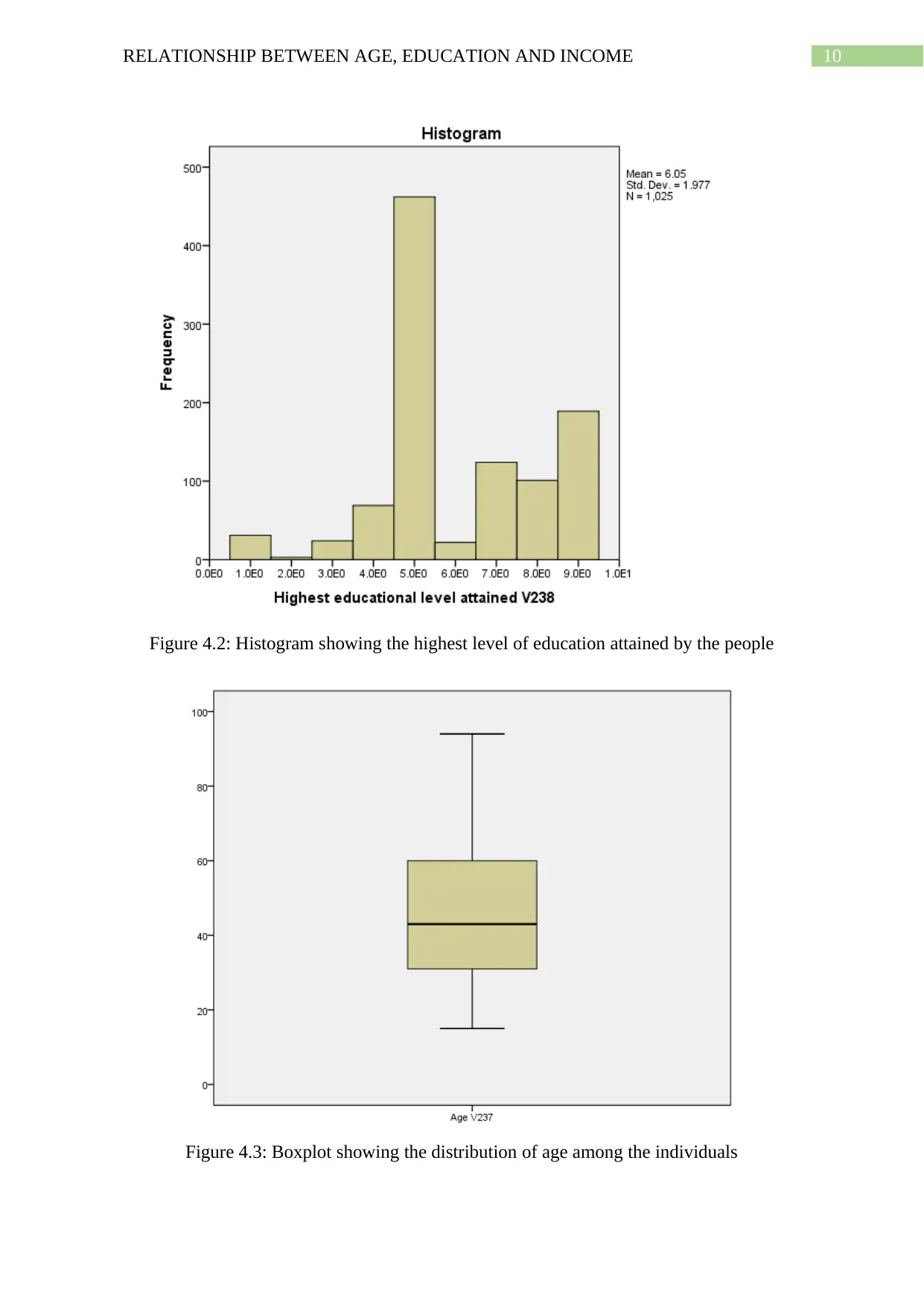
10RELATIONSHIP BETWEEN AGE, EDUCATION AND INCOME
Figure 4.2: Histogram showing the highest level of education attained by the people
Figure 4.3: Boxplot showing the distribution of age among the individuals
Figure 4.2: Histogram showing the highest level of education attained by the people
Figure 4.3: Boxplot showing the distribution of age among the individuals
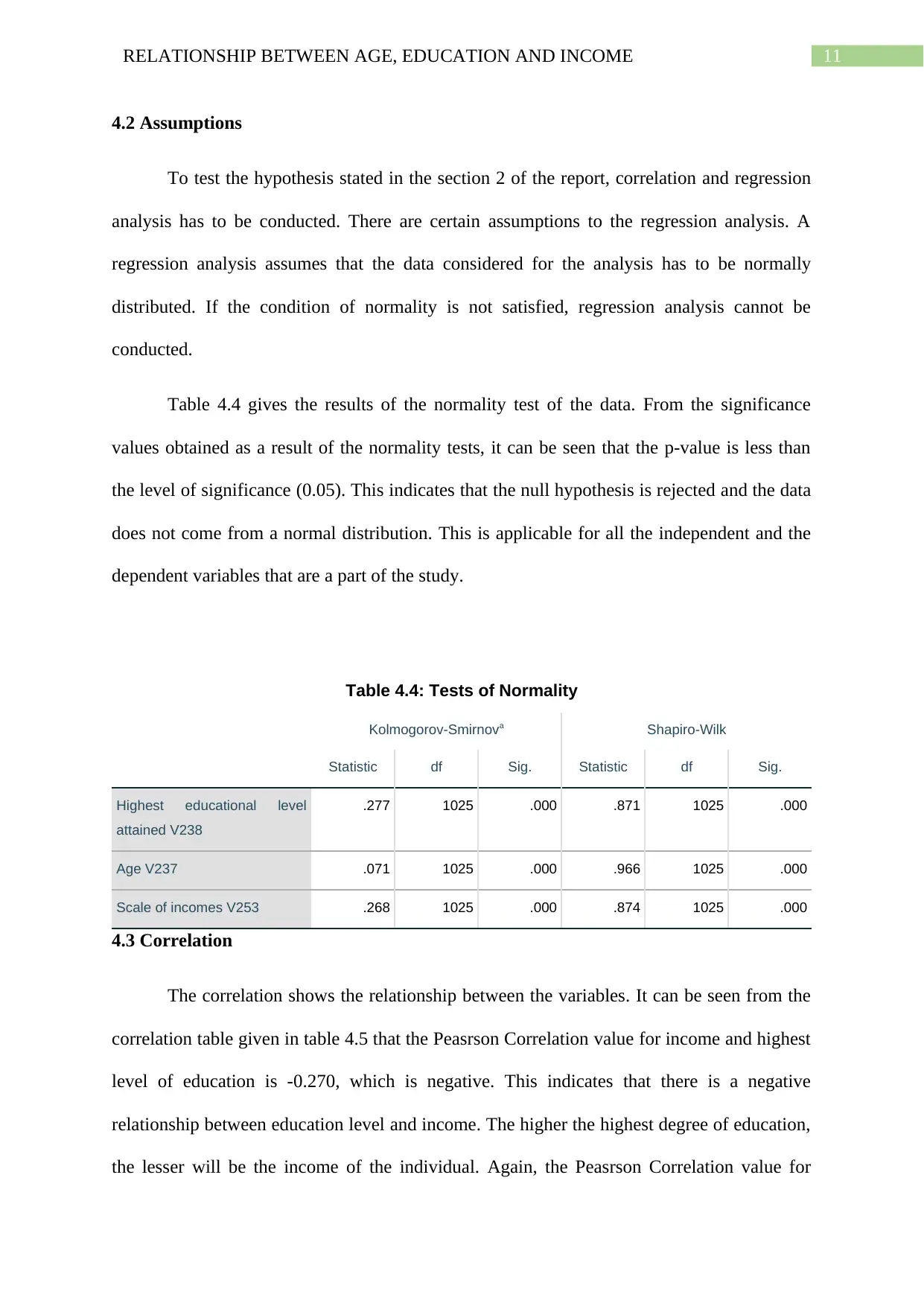
11RELATIONSHIP BETWEEN AGE, EDUCATION AND INCOME
4.2 Assumptions
To test the hypothesis stated in the section 2 of the report, correlation and regression
analysis has to be conducted. There are certain assumptions to the regression analysis. A
regression analysis assumes that the data considered for the analysis has to be normally
distributed. If the condition of normality is not satisfied, regression analysis cannot be
conducted.
Table 4.4 gives the results of the normality test of the data. From the significance
values obtained as a result of the normality tests, it can be seen that the p-value is less than
the level of significance (0.05). This indicates that the null hypothesis is rejected and the data
does not come from a normal distribution. This is applicable for all the independent and the
dependent variables that are a part of the study.
Table 4.4: Tests of Normality
Kolmogorov-Smirnova Shapiro-Wilk
Statistic df Sig. Statistic df Sig.
Highest educational level
attained V238
.277 1025 .000 .871 1025 .000
Age V237 .071 1025 .000 .966 1025 .000
Scale of incomes V253 .268 1025 .000 .874 1025 .000
4.3 Correlation
The correlation shows the relationship between the variables. It can be seen from the
correlation table given in table 4.5 that the Peasrson Correlation value for income and highest
level of education is -0.270, which is negative. This indicates that there is a negative
relationship between education level and income. The higher the highest degree of education,
the lesser will be the income of the individual. Again, the Peasrson Correlation value for
4.2 Assumptions
To test the hypothesis stated in the section 2 of the report, correlation and regression
analysis has to be conducted. There are certain assumptions to the regression analysis. A
regression analysis assumes that the data considered for the analysis has to be normally
distributed. If the condition of normality is not satisfied, regression analysis cannot be
conducted.
Table 4.4 gives the results of the normality test of the data. From the significance
values obtained as a result of the normality tests, it can be seen that the p-value is less than
the level of significance (0.05). This indicates that the null hypothesis is rejected and the data
does not come from a normal distribution. This is applicable for all the independent and the
dependent variables that are a part of the study.
Table 4.4: Tests of Normality
Kolmogorov-Smirnova Shapiro-Wilk
Statistic df Sig. Statistic df Sig.
Highest educational level
attained V238
.277 1025 .000 .871 1025 .000
Age V237 .071 1025 .000 .966 1025 .000
Scale of incomes V253 .268 1025 .000 .874 1025 .000
4.3 Correlation
The correlation shows the relationship between the variables. It can be seen from the
correlation table given in table 4.5 that the Peasrson Correlation value for income and highest
level of education is -0.270, which is negative. This indicates that there is a negative
relationship between education level and income. The higher the highest degree of education,
the lesser will be the income of the individual. Again, the Peasrson Correlation value for
⊘ This is a preview!⊘
Do you want full access?
Subscribe today to unlock all pages.

Trusted by 1+ million students worldwide
1 out of 19
Related Documents
Your All-in-One AI-Powered Toolkit for Academic Success.
+13062052269
info@desklib.com
Available 24*7 on WhatsApp / Email
![[object Object]](/_next/static/media/star-bottom.7253800d.svg)
Unlock your academic potential
Copyright © 2020–2025 A2Z Services. All Rights Reserved. Developed and managed by ZUCOL.





